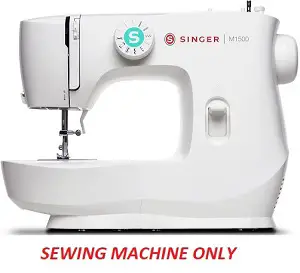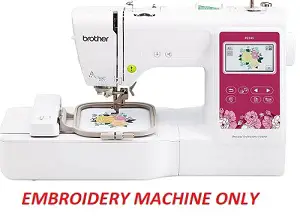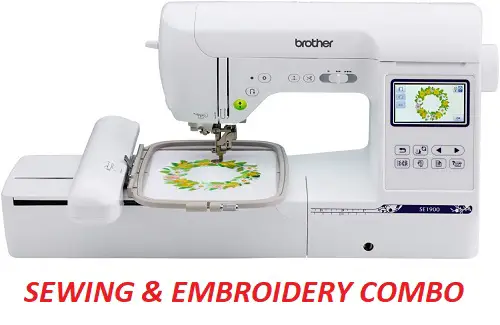A sewing and embroidery machine is a specialized piece of equipment that combines the functionality of a traditional sewing machine with the capability to add decorative embroidery to fabrics. These machines are designed to cater to both basic sewing tasks and more intricate embellishments, making them versatile tools for a variety of creative projects.

Sewing Machine: A sewing machine is a mechanical or electronic device designed to stitch fabric and other materials together with thread. It automates the process of stitching, making it faster and more efficient than sewing by hand.

Embroidery Machine: An embroidery machine is a type of sewing machine, designed specifically for creating intricate and decorative embroidery on fabric and other materials. Unlike regular sewing machines, embroidery machines are equipped with features and capabilities that enable them to stitch complex designs, patterns, and even lettering onto textiles.

Sewing and Embroidery Machine Combo: A sewing and embroidery machine combo, also known as a combination machine, is a versatile piece of equipment that integrates both sewing and embroidery functions into a single unit. This type of machine allows users to switch between traditional sewing tasks and decorative embroidery without the need for separate devices.
Difference between Sewing Machine and Embroidery Machine (Sewing machine VS Embroidery Machine)
Here’s a table highlighting the key differences between a sewing machine and an embroidery machine:
| Feature | Sewing Machine | Embroidery Machine |
|---|---|---|
| Primary Function | Stitching fabric together for seams, hems, etc. | Creating decorative embroidery designs on fabric |
| Needle | Single needle for basic stitching | Single or multiple needles for intricate designs |
| Stitches | Offers a variety of basic stitches | Focuses on decorative stitches and embroidery designs |
| Hoop | Does not typically use an embroidery hoop | Requires an embroidery hoop to hold fabric taut during embroidery |
| Feed Dogs | Moves fabric under the needle for sewing | Helps move fabric during embroidery, ensuring precise design placement |
| Built-in Designs | Limited or no built-in embroidery designs | Comes with a variety of built-in embroidery designs and fonts |
| Editing Capabilities | Basic stitching adjustments | Advanced editing features for resizing, rotating, and customizing designs |
| Connectivity | May not have USB ports or Wi-Fi connectivity | Often equipped with USB ports and sometimes Wi-Fi for importing custom designs |
| Dual Functionality | Primarily designed for sewing | May have dual functionality, combining sewing and embroidery capabilities |
| Size of Embroidery Area | N/A (Not applicable for basic sewing) | Specifies the maximum space available for embroidery designs |
| Suitable Projects | Versatile for garment construction, alterations, and basic projects | Ideal for projects requiring decorative embellishments, personalized designs, and embroidery |
| Skill Level | Suitable for all skill levels | Ranges from beginner-friendly to advanced models |
| Cost | Generally more affordable | Can be more expensive due to additional embroidery features |
This table provides a concise overview of the main distinctions between sewing machines and embroidery machines. Keep in mind that there are combination machines that integrate both sewing and embroidery functions, offering a versatile solution for various creative projects.
Sewing machine importance:
- Efficiency: Sewing machines significantly reduce stitching time, enhancing overall efficiency compared to hand sewing.
- Precision and Consistency: These machines ensure precise and consistent stitches, contributing to the quality and durability of the final product.
- Versatility: With a variety of stitches and features, sewing machines are versatile tools suitable for a range of projects, from basic repairs to intricate creations.
- Cost Savings: Home sewing using a machine allows for DIY repairs and alterations, leading to significant cost savings on professional tailoring services.
- Professional Finish: Sewing machines provide a polished finish to garments, enhancing their appearance and appeal.
- Empowerment and Self-Sufficiency: Owning a sewing machine empowers individuals to create, repair, and customize clothing, fostering a sense of self-sufficiency.
- Therapeutic Benefits: Engaging in sewing can have therapeutic benefits, offering a creative outlet for relaxation and stress relief.
Embroidery Machine Importance:
- Artistic Precision: Embroidery machines deliver intricate and precise decorative stitching, elevating the artistic appeal of fabrics and garments.
- Time-Saving Embellishments: With specialized features for embroidery, these machines save time by automating the creation of intricate designs, patterns, and lettering.
- Versatile Creativity: Embroidery machines offer a wide range of built-in designs and fonts, fostering creativity and allowing users to personalize their projects.
- Efficient Editing: Users can easily edit and customize embroidery designs on the machine, adjusting size, rotation, and other parameters for optimal creativity.
- Professional Finishing Touch: The polished finish provided by embroidery machines adds a professional touch to garments, home decor items, and accessories.
- Flexible Applications: From monogramming to decorative stitching, embroidery machines cater to a variety of applications, enhancing the visual appeal of diverse projects.
- Empowering Artisans: Owning an embroidery machine empowers artisans to express themselves artistically, whether through intricate patterns or personalized designs.
Why sewing and embroidery machine combo is the best choice?
Sewing and embroidery are considered the best for several reasons:
- Versatility: The combination of sewing and embroidery provides a versatile range of creative possibilities, allowing individuals to undertake diverse projects, from basic garment construction to intricate and decorative stitching.
- Customization: The ability to sew and embroider enables users to customize their clothing, accessories, and home decor items, adding a personal touch and expressing individual style.
- Skill Development: Engaging in sewing and embroidery fosters skill development, offering a satisfying learning curve for beginners and continuous challenges for those seeking to enhance their craft.
- Cost-Efficiency: By sewing and embroidering at home, individuals can save on professional tailoring services and create unique, personalized items without the high costs associated with custom-made products.
- Sustainability: Repairing, altering, and embellishing existing garments through sewing and embroidery contribute to sustainable practices by reducing the need for new purchases and minimizing textile waste.
- Therapeutic Benefits: The creative and hands-on nature of sewing and embroidery provides therapeutic benefits, offering a mindful and relaxing activity that promotes stress relief and creative expression.
- Community Building: Sewing and embroidery communities, both online and offline, provide platforms for sharing skills, ideas, and inspiration, fostering a sense of community among individuals with a shared passion.
- Artistic Expression: The ability to create intricate and unique designs through embroidery, coupled with the practical skill of sewing, allows for a seamless blend of both artistic expression and functional craftsmanship.
- Empowerment: Owning the skills to sew and embroider empowers individuals to take control of their wardrobe, home decor, and gifts, promoting a sense of self-sufficiency and creative autonomy.
- Tradition and Modernity: Sewing and embroidery connect tradition with modernity, allowing individuals to embrace traditional crafts while incorporating modern techniques, materials, and designs.
In summary, the combination of sewing and embroidery is celebrated for its versatility, personalization opportunities, skill development, cost-efficiency, sustainability, therapeutic benefits, community engagement, artistic expression, empowerment, and the blending of traditional and modern elements. These factors collectively contribute to the enduring popularity and appeal of sewing and embroidery as creative and practical pursuits.
Basic Parts of Sewing and Embroidery Machine:
The basic parts of a sewing and embroidery machine are similar, as embroidery machines are essentially specialized sewing machines with added features for decorative stitching. Here are the fundamental components found in these machines:
- Needle:
- The needle is a small, pointed metal rod that pierces the fabric to create stitches.
- Presser Foot:
- The presser foot holds the fabric in place during sewing and embroidery. It applies pressure to ensure smooth fabric feeding.
- Feed Dogs:
- The feed dogs have metal teeth beneath the needle plate. They move the fabric forward as stitches are formed, ensuring even stitching.
- Bobbin:
- The bobbin holds the bottom thread and works in conjunction with the upper thread to create stitches.
- Bobbin Case:
- The bobbin case holds the bobbin in place and provides tension to the lower thread.
- Tension Discs:
- Tension discs control the tension of the upper thread, ensuring balanced and neat stitches.
- Needle Plate:
- The needle plate is a metal plate with an opening through which the needle passes. It provides support for the fabric during stitching.
- Stitch Selector:
- The stitch selector allows users to choose from various types of stitches available on the machine.
- Stitch Length and Width Controls:
- These controls enable users to adjust the length and width of stitches based on the requirements of the sewing or embroidery project.
- Thread Cutter:
- Some machines have a built-in thread cutter for conveniently trimming excess thread.
- Embroidery Arm:
- The embroidery arm is a movable component that holds the needle and allows it to travel across the fabric to create embroidery designs.
- Embroidery Hoop:
- The embroidery hoop is a frame that holds the fabric taut during the embroidery process, ensuring precise stitching.
- Touchscreen or Control Panel:
- Many modern machines come equipped with a touchscreen or control panel for easy navigation and customization of settings.
- Bobbin Winder:
- The bobbin winder allows users to wind thread onto the bobbin quickly and evenly.
- LED Lighting:
- LED lights illuminate the sewing area, providing clear visibility during stitching and embroidery.
These are the basic components that make up a sewing and embroidery machine. Keep in mind that specific models may have additional features and parts, depending on their complexity and capabilities.
What To Look To Buy A Sewing Machine
When looking to buy a sewing and embroidery machine, consider the following factors to ensure you find a machine that meets your needs and preferences:
- Machine Type:
- Decide whether you want a combination machine (sewing and embroidery in one) or if you prefer separate machines for each function.
- Brand Reputation:
- Research reputable brands are known for producing quality sewing and embroidery machines. Popular brands include Brother, Singer, Janome, and Pfaff.
- Machine Features:
- Consider the features that are important to you, such as the embroidery area size, built-in designs, editing capabilities, and ease of use. Look for features that match your creative needs.
- User Interface:
- Check the machine’s user interface. Touchscreens, easy navigation, and intuitive controls can enhance your overall experience, especially if you’re a beginner.
- Embroidery Designs and Fonts:
- Evaluate the number and variety of built-in embroidery designs and fonts. Some machines offer a wide range of options, while others may have fewer choices.
- Editing Capabilities:
- Look for machines with comprehensive editing features, such as resizing, rotating, and combining designs. Advanced editing capabilities provide more creative freedom.
- Connectivity Options:
- Check if the machine has USB ports or Wi-Fi connectivity. This allows you to import custom designs and patterns easily.
- Embroidery Hoops:
- Consider the variety and sizes of embroidery hoops that come with the machine. Different hoop sizes enable you to work on various projects.
- Stitching and Sewing Features:
- Pay attention to the types of stitches available for sewing. Ensure the machine meets your sewing needs with basic and decorative stitch options.
- Automatic Features:
- Look for automatic features such as thread tension adjustment, thread cutting, and needle threading. These features enhance convenience and ease of use.
- Machine Speed and Stability:
- Check the machine’s speed settings and stability during operation. A stable machine with adjustable speed can accommodate various projects and skill levels.
- Reviews and Ratings:
- Read user reviews and ratings to get insights into real-world experiences with the specific machine model you are considering.
- Warranty and Support:
- Check the warranty offered by the manufacturer. Additionally, consider the availability of customer support and service centers.
- Price and Budget:
- Set a budget based on your affordability. Compare prices across different brands and models, considering the features each offers.
- Skill Level:
- Consider your skill level. Some machines are designed for beginners, while others cater to more advanced users. Choose a machine that aligns with your expertise.
- Space and Portability:
- Assess the size of the machine and whether it fits your workspace. If portability is essential, consider the weight and dimensions for easy storage or transport.
By carefully considering these factors, you can choose a sewing and embroidery machine that aligns with your preferences, creative needs, and skill level.
Let’s Discuss some topics about sewing and embroidery machine:
Best Quality Thread For Sewing Machine: Selecting the best quality thread is essential for achieving durable and aesthetically pleasing stitches. High-quality threads, such as those made from long-staple cotton or polyester, offer strength, minimal lint, and colorfastness. Choosing the appropriate thread for specific fabrics and projects enhances sewing machine performance and the longevity of the finished garments.
Affordable Sewing Machines for Beginners: Beginners in the world of sewing often seek affordable yet reliable machines to kickstart their journey. Entry-level sewing machines with basic features, easy controls, and user-friendly designs are ideal for newcomers. Brands like Brother, Singer, and Janome offer budget-friendly options without compromising on essential functionalities, making it easier for beginners to learn and practice.
Best Sewing And Embroidery Machine Combo For Beginners: Novice sewers and crafters benefit from all-in-one sewing and embroidery machine combos. These machines provide a seamless transition between basic sewing tasks and creative embroidery projects. Models from reputable brands, offering user-friendly interfaces, built-in designs, and essential editing features, cater to beginners’ needs, fostering skill development and creativity in one versatile unit.
Best Multi-Needle Embroidery Machine For Home Business: For individuals running a home-based embroidery business, a multi-needle embroidery machine proves invaluable. These machines, with multiple needles and efficient thread management, allow for faster production and intricate designs. Brands like Baby Lock and Brother offer reliable multi-needle options suitable for home-based entrepreneurs, balancing productivity and creativity in the embroidery business.
What Is The Best Sewing Embroidery Monogramming Machine for Small Businesses?: For small businesses involving sewing, embroidery, and monogramming, the Brother SE1900 stands out with its diverse features, including 138 built-in designs, a large embroidery field, and advanced functionality. Additionally, the Janome Memory Craft 500E and Bernina 350 PE offer notable options with various built-in designs, USB connectivity, and user-friendly features. Consider your specific business needs, budget, and desired functionalities when choosing the best machine for your small business
Embroidery Machine VS Monogramming Machine: Embroidery machines and monogramming machines, while similar in function, serve distinct purposes in fabric decoration. An embroidery machine is designed for creating a wide range of intricate and colorful designs, including complex artwork and patterns. It offers versatility with various stitch types and a larger working area and often includes the capability to download or create custom designs. A monogramming machine, in contrast, specializes in stitching monograms – designs composed of letters, usually initials. These machines focus on lettering and simple designs, making them ideal for personalizing items with names or initials. While both machines embellish fabric, the key difference lies in their specialization: embroidery machines for diverse designs and monogramming machines for letter-focused work.